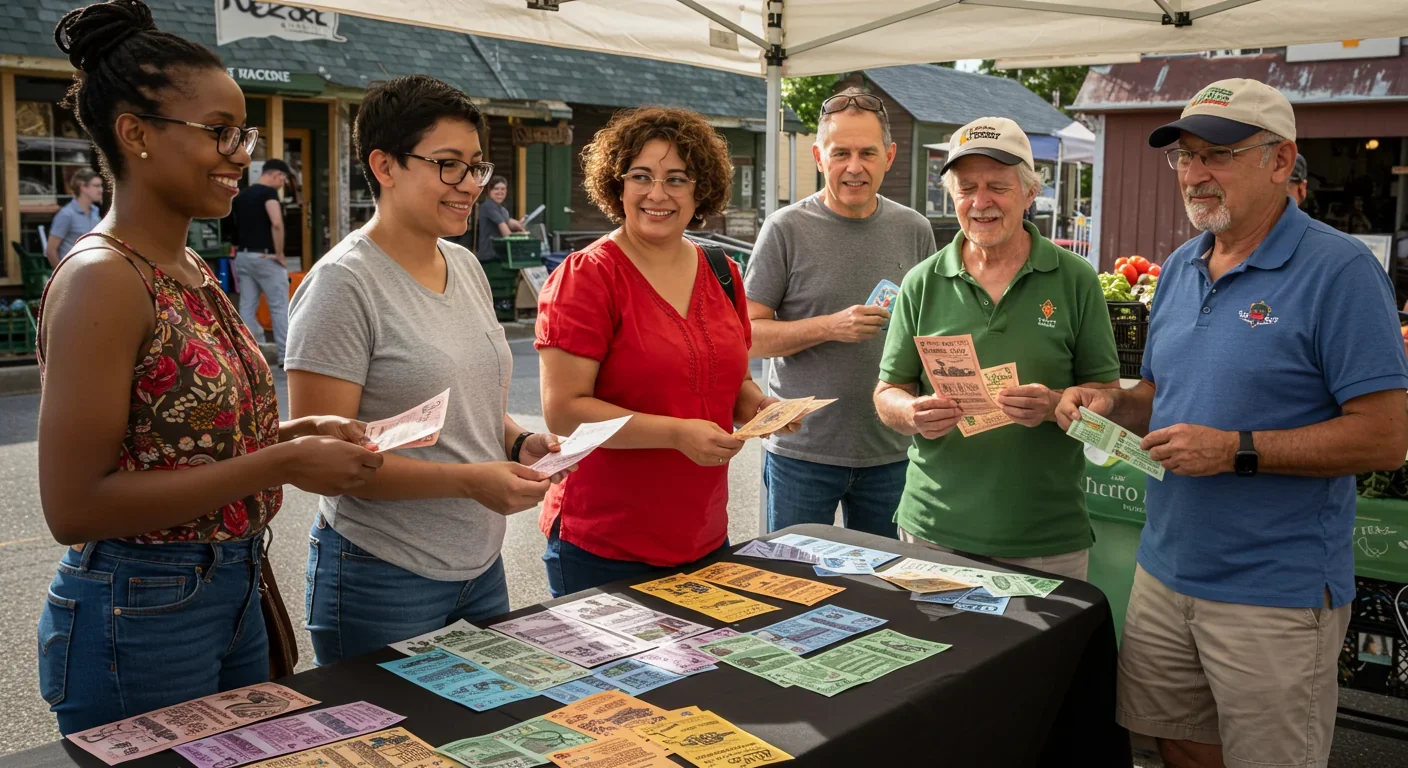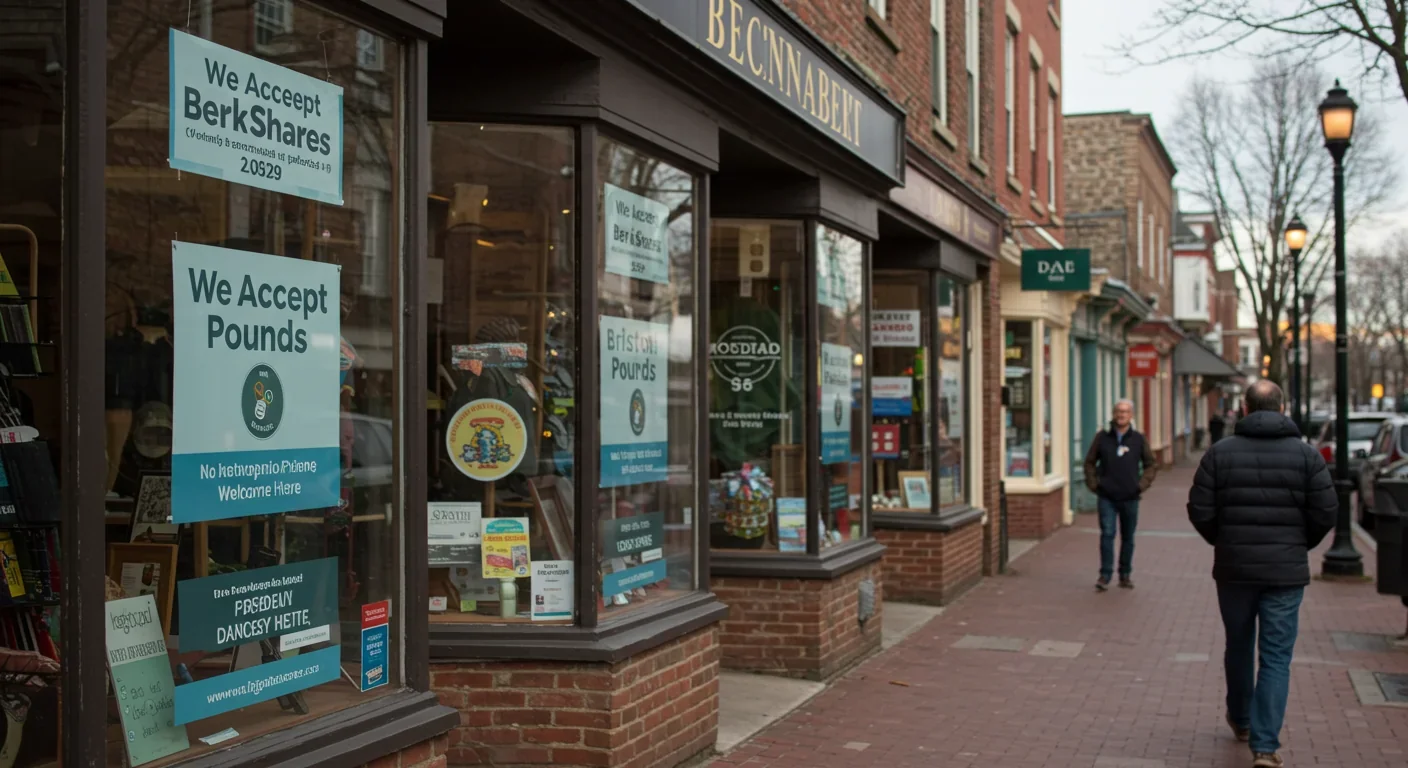When Reality Becomes Partisan: The Death of Shared Truth

TL;DR: Community currencies like BerkShares and Bristol Pounds are local monetary systems that keep wealth circulating within communities rather than being extracted by corporate banks. While around 300 operate globally with some notable successes, they face challenges in scaling and sustainability, representing experiments in economic sovereignty that challenge who controls money.

Walk into a shop in the Berkshires and you might pay with a BerkShare. Grab coffee in what used to be Brixton, London, and the Brixton Pound once bought your latte. These aren't relics or curiosities. They're weapons in a quiet financial revolution happening in communities worldwide—a systematic rejection of corporate banking that's keeping wealth local and rebuilding economic sovereignty from the ground up.
Around 300 complementary currencies operate globally right now, and they're doing something remarkable. They're proving you don't need Wall Street's permission to build an economy that actually serves your neighbors.
Community currencies work through elegant simplicity. Take BerkShares, which launched in Massachusetts in 2006. You exchange 95 U.S. dollars at any of 16 participating local banks for 100 BerkShares—an instant 5% incentive to spend locally. Those dollars sit in reserve, backing every note in circulation. Shop owners accepting BerkShares can spend them with other local businesses or convert them back at the bank, though at the original exchange rate. The built-in discount encourages the currency to keep moving through the local economy rather than leak out to distant corporate headquarters.
The brilliance lies in what happens next. Every pound spent in a local shop using a community currency generates £1.76 worth of value for the local economy, compared to just 36 pence when spent with national chains. That's not accounting magic. It's the difference between money that circulates through your community five or six times versus money that gets extracted once and disappears into shareholder dividends in New York or London.
Different systems use different mechanisms. Ithaca Hours, which operated in upstate New York from 1991 until recently, valued each note at $10—representing roughly one hour of labor at the then-average wage. Over a thousand individuals and 500 businesses accepted Hours. Several million dollars' worth changed hands before the system wound down, done in partly by the digital payment revolution it couldn't match.
Switzerland's WIR system takes yet another approach. Operating since 1934, it's a credit-clearing network for businesses where WIR credits aren't convertible to francs—they must circulate within the network. The system charges a 1% transaction fee that funds administration. Tens of thousands of Swiss businesses use it to smooth cash flow and build trading relationships that wouldn't exist in the conventional economy.
The 2008 financial crisis was an awakening. While governments bailed out the banks that caused the crash, communities watched their main streets hollow out, local businesses fail, and wealth flow upward to distant financial centers that cared nothing for their survival.
"The Brixton Pound was set up by a group of local activists who wanted to do something in response to the financial crisis," explained Marta Owczarek, communications manager for the project. They weren't economists or bankers. They were people who'd had enough of watching their community's wealth extracted by institutions that gave nothing back.
Corporate banking operates on extraction. A coffee shop in a small town deposits money at a national bank, which lends it to corporations thousands of miles away. The profits from those loans don't return to fund local mortgages or small business growth. They boost quarterly earnings reports and executive compensation packages. It's an efficient system for concentrating wealth, terrible for building community resilience.
Community currencies flip that model. They're designed to trap wealth in a specific geographic area by making it either inconvenient or impossible to spend elsewhere. The currency becomes a commons—a shared resource that gains value through collective agreement rather than central bank fiat. When your town prints its own money and your neighbors accept it, you're engaging in an act of monetary sovereignty that most people assume died with the nation-state.

Over 10 million BerkShares have been issued since 2006. That's not pocket change for a rural Massachusetts region. At its peak, 400 businesses accepted the currency, though that number has declined to around 300 by 2024—still a substantial network proving daily that alternatives to Federal Reserve notes can function in the modern economy.
The Bristol Pound in England made history as the first UK local currency accepted for payment of city taxes. Between 2012 and 2023, it put approximately £2.5 million into circulation, engaging 850 local businesses and 1,400 account holders. Even local government employees could receive part of their salary in Bristol Pounds through a city payroll scheme. That level of institutional support transformed the currency from activist project to legitimate economic infrastructure.
Technology has enabled new models. The city of Lugano, Switzerland launched the LVGA token, a cryptocurrency linked to the Swiss Franc offering 10% cashback at participating stores. That's a more aggressive incentive structure than traditional paper currencies can offer, made possible by digital systems that track and reward spending patterns in real-time.
In Spain's Basque region, the Ekhilur currency in Hernani generated 5 million euros in sales and 200,000 transactions over just two years in a town of 20,000 people. That's extraordinary penetration—proof that under the right conditions, local currencies can become genuine parallel systems rather than symbolic gestures.
The Brixton Pound pioneered fintech integration that made adoption practical for non-tech-savvy users. A pay-by-text system let people make payments without internet access—crucial for bridging the digital divide. A custom ATM in Brixton Market dispensed paper Brixton Pounds. These innovations addressed the biggest barrier to local currencies: convenience. Make it harder to use than national currency and adoption dies. Match or exceed that convenience and you have a chance.
Not every community currency succeeds. The Bristol Pound, despite its achievements, wound up operations in 2023 after eleven years. The Lewes Pound, Britain's last operating local paper currency, ceased circulation after 17 years. The Ithaca Hours, once the poster child for community currencies in America, faded when founder Paul Glover moved away and the shift to credit cards and digital payments made paper scrip feel antiquated.
Three failure patterns emerge from studying dead currencies. First, they're personality-dependent. When a charismatic founder or small core team drives the project, their departure often proves fatal. The Ithaca Hours declined largely because Glover's energy and vision weren't successfully transferred to a sustainable organizational structure.
Second, they struggle with the digital transition. Paper currencies seemed viable in the 1990s and early 2000s. By 2020, asking people to carry special cash for local purchases felt like asking them to use a flip phone. The successful currencies have either adapted to digital payments or found ways to integrate with existing payment infrastructure. Those that stayed paper-only mostly died.
Third, the regulatory burden can crush small operations. In the United States, local exchange trading systems (LETS) must report transaction values to the IRS for each participant, treating them as barter systems. That creates administrative costs and complexity that volunteer organizations struggle to manage. The legal ambiguity around what counts as currency, security, or barter varies by jurisdiction and creates enough uncertainty to deter many would-be organizers.
The sustainability challenge goes deeper than technology or regulations. Community currencies need critical mass. If only 20 businesses accept the currency, users can't make it their primary spending method. But convincing businesses to accept a new currency requires proof of customer demand. That chicken-and-egg problem has killed more currencies than any external obstacle. Success requires either a rapid launch with enough initial participants to create momentum, or patient, slow building of a network over years—a timeline most activist projects can't sustain.
The cryptocurrency wave promised to solve community currency problems through decentralization, programmability, and instant global transactions. Platforms like Bancor and Holochain emerged offering communities the ability to launch tokens with custom governance rules, low transaction fees, and integration with global crypto markets.
The Brixton Pound announced it would relaunch as the first major urban currency on a blockchain platform. Wyoming's state government created Frontier, a government-backed stablecoin backed by cash and short-duration treasuries at 102% reserves—bringing legitimacy and regulatory compliance to the crypto community currency concept.
Yet blockchain solutions introduce new problems while solving old ones. Crypto's volatility is poison for something meant to be a stable medium of exchange. Stablecoins address this by pegging to national currencies, but that undermines the sovereignty goal—you're still dependent on the dollar or euro. Truly independent cryptocurrencies face the same adoption barriers that doomed paper currencies, plus added complexity. Explaining blockchain to your local baker is harder than handing them a pretty banknote.
The energy costs of many blockchain systems conflict with the ecological values motivating many community currency advocates. And crypto's association with speculation, scams, and libertarian ideology can alienate communities whose interest in local currency springs from progressive politics focused on cooperation and environmental sustainability.
Technology should serve the currency's goals, not become the goal itself. The Brixton Pound's pay-by-text system succeeded not because it was cutting-edge but because it matched how people already used phones. The best blockchain implementations will be those invisible to users—backend infrastructure that makes local currency easier without requiring anyone to understand distributed ledgers or private keys.

Community currencies occupy a strange legal position. They're generally permitted as long as they don't claim to be legal tender or attempt to replace national currency. The legal principle is straightforward: you can trade anything by mutual agreement—baseball cards, babysitting hours, or specially printed notes—as long as both parties consent and you meet tax obligations.
But "generally permitted" isn't the same as clearly regulated. The lack of specific legal frameworks means organizers operate in uncertainty. The IRS treats LETS as barter, requiring reporting of every transaction. The Financial Crimes Enforcement Network (FinCEN) might classify some digital community currencies as money service businesses, triggering expensive compliance requirements. State money transmitter laws vary wildly, with some states considering even small-scale local currencies as requiring licensure.
The GENIUS Act proposed in Congress would mandate that payment stablecoin issuers maintain 100% liquid reserves and submit to regular audits. That's sensible consumer protection, but it would make launching a community currency dramatically more expensive and complex. You'd need professional audits, regulatory lawyers, and significant capital just to print some local money.
No documented cases exist of corporate banks actively opposing community currencies through legal means, but the absence of opposition might reflect how little threat the movement currently poses to their dominance. The ACH network moves nearly $39 trillion annually through 22 billion transactions. Even the most successful community currencies are rounding errors in that system. Banks can afford to ignore them—for now.
The regulatory challenge shapes which communities can launch currencies. Wealthy areas with professional networks and philanthropic support can afford legal advice and compliance costs. Working-class communities that might benefit most from keeping wealth local often can't muster the resources to navigate the legal complexity. That's not an accident. Financial regulation evolved to protect the existing system, not to enable alternatives.
Starting a community currency requires answering hard questions before printing a single note. Who will be the issuing authority? A nonprofit provides legitimacy and tax benefits but requires formal governance. A loose collective is easier to start but harder to sustain. Early decisions create path dependencies that shape everything that follows.
How will the currency be backed? Dollar-pegged systems like BerkShares require participating banks willing to hold reserves—a partnership that demands trust and legal clarity. Non-backed currencies like Ithaca Hours rely purely on community agreement, which sounds democratic but makes the currency vulnerable to value fluctuations based on perception.
What's your sustainability model? Most community currencies start with grants or donations and struggle when that funding ends. Transaction fees like WIR's 1% charge can fund administration, but merchants resist fees that eat into already thin margins. Some currencies use demurrage—a tax that devalues the currency over time—to encourage spending rather than hoarding, though explaining why your money loses value requires skilled communication.
You need a critical mass strategy. The chicken-and-egg problem is real. Launching with at least 50 businesses committed to accepting the currency gives users enough places to spend it to make participation worthwhile. Getting those 50 businesses requires either a tight-knit community with strong social bonds or incentives compelling enough to overcome skepticism. The 5% discount built into BerkShares' exchange rate provides that incentive. Other successful launches have leveraged local pride, environmental commitments, or dissatisfaction with conventional banking as mobilizing narratives.
Technology decisions matter more than ever. Paper is romantic but increasingly impractical. Pure cryptocurrency alienates non-technical users. The sweet spot might be a smartphone app with a paper backup option, or integration with existing payment terminals so merchants don't need new hardware. Whatever you choose, the technology must be more convenient than the national currency it competes against, or simpler than the social bonds holding the community together are strong.
Legal groundwork comes before launch. Consult lawyers familiar with money service business regulations in your jurisdiction. Structure your organization to minimize personal liability for organizers. Develop clear terms of use that protect you from claims the currency is a security or investment. Budget for compliance costs—they're not exciting but they're necessary if you want to last beyond the initial enthusiasm.
Most importantly, start with honest conversations about goals. If you want to make a political statement about corporate banking, a small-scale symbolic currency might suffice. If you aim to meaningfully alter local economic flows, you need business owners, local government, and eventually banks on board. Those are different projects requiring different strategies. Many currencies fail because organizers never align on which game they're playing.
Mainstream economists tend to be skeptical of community currencies, viewing them as solutions to problems that don't exist. National currencies backed by central banks provide stability, liquidity, and universal acceptance—qualities that centuries of monetary evolution optimized. From this perspective, local currencies add friction and inefficiency without meaningful benefit.
The counterargument from ecological economists and degrowth advocates is that mainstream economics misses the point. Efficiency in service of wealth extraction isn't a virtue. If the global financial system efficiently funnels money from communities to rentiers, maybe friction is exactly what's needed. Local currencies are speed bumps forcing wealth to slow down and irrigate the landscape rather than flow straight to the ocean.
The research on economic impacts remains limited. The £1.76 multiplier claimed for local spending versus £0.36 for external spending is frequently cited but comes from studies with methodological challenges. Isolating the effects of local currency from other factors affecting community economic health is difficult. Correlation doesn't prove causation—thriving communities might adopt local currencies because they're already strong, not become strong because they adopted a currency.
What's less debatable is the social capital effect. Communities that launch currencies build networks, trust, and shared identity in the process. Those intangibles have economic value even if they're hard to quantify. The Transition Town movement, which birthed many UK local currencies, emphasizes this explicitly. The currency is a tool for community-building as much as economic restructuring. Whether that's worth the effort depends on what you value.
Some economists see community currencies as useful experiments in monetary design. They're laboratories testing alternative backing mechanisms, governance structures, and incentive systems at scales small enough that failure doesn't cause systemic harm. The demurrage concept pioneered by currencies like Chiemgauer challenges assumptions about money needing to be a store of value. What if currency was designed to circulate rather than accumulate? The experiments don't need to replace national currencies to generate insights that might inform central bank digital currencies or payment system redesigns.
Here's the uncomfortable truth. After decades of community currency experiments, they remain niche. The most successful examples engage hundreds or at most thousands of active users in a world of billions. No community currency has broken out to regional or national significance as a primary medium of exchange. They exist in the margins, tolerated by the dominant system because they don't threaten it.
Scalability faces mathematical and social limits. The trust and social cohesion enabling BerkShares to work in a tight-knit rural region don't translate to anonymous urban environments or across regional boundaries. You can't base a currency for 10 million people on everybody knowing each other. At scale, you need the impersonal institutions—banks, regulators, enforcement mechanisms—that local currencies exist to escape.
Technical solutions might change this calculation. Blockchain platforms enabling interoperability between different local currencies could create a network effect. Imagine spending Berkshares in Brixton or Bristol Pounds in Barcelona because they're all compatible tokens on a shared protocol. That would preserve local control while enabling broader utility. But it would also introduce the complexity and coordination problems that make national currencies necessary in the first place.
Maybe the question of scale is the wrong question. Community currencies might be inherently local precisely because their benefits come from locality. They're tools for communities small enough that social bonds matter and collective action is possible. Asking if they can scale is like asking if community gardens can replace industrial agriculture. That's not their purpose.
The more relevant question might be whether community currencies can proliferate. Could thousands of local systems coexist, each serving its community without needing to become dominant? That's a different vision of economic future—polycentric rather than monolithic, with diverse currencies for diverse contexts instead of one-size-fits-all money controlled from distant financial centers.
Some advocates see community currencies as survival tools for the transitions ahead. As climate change, resource depletion, and economic instability strain global systems, the communities with local economic structures might prove more resilient. The local currency becomes insurance—a backup system that works when the primary system fails. From that perspective, success isn't measured in transaction volume but in whether the infrastructure exists when it's needed.
The story of community currencies is really a story about power—who holds it, who wields it, and who dares to build alternatives when the existing system serves them poorly. Money is the most powerful social technology humans have created, and for most of modern history we've accepted that its design is beyond our control, determined by central banks and financial institutions acting in their own interests.
Community currencies prove that's a lie. Money is an agreement. It works because people agree it works. When your community agrees that a piece of paper with a local bridge printed on it has value, it has value. That agreement is an act of collective self-determination with more radical implications than most political activism because it strikes at the foundation of economic power.
We're living through a moment of monetary experimentation unlike any since the gold standard collapsed. Central bank digital currencies, cryptocurrencies, stablecoins, and community currencies all represent attempts to reimagine what money is and who controls it. The outcome isn't predetermined. The financial system you'll use in 20 years doesn't exist yet, and communities bold enough to print their own money today are helping write the rules that will govern everyone tomorrow.
The barriers to starting a community currency have never been lower. Technology exists to handle the hard parts. Legal frameworks, while imperfect, provide enough clarity to proceed. What's missing isn't tools or knowledge. It's will—the decision that extractive corporate banking isn't inevitable, that your community deserves to keep its wealth local, and that you're willing to do the unglamorous work of building alternatives.
The communities that have succeeded didn't wait for permission or perfect conditions. They started with a few committed people, enrolled some local businesses, and figured out the rest through experimentation. Some failed. Some thrived. All of them proved that declaring financial independence from corporate banks is possible.
So the question isn't whether community currencies work. The evidence says they can, in the right contexts, with the right design. The question is whether you care enough about where money flows in your community to do something about it. Because if you don't, the default is clear: wealth extraction will continue, corporate banks will keep winning, and your community will remain economically colonized by institutions that exist to serve themselves.
Or you could print your own money. The choice, for once, is actually yours.

Curiosity rover detects mysterious methane spikes on Mars that vanish within hours, defying atmospheric models. Scientists debate whether the source is hidden microbial life or geological processes, while new research reveals UV-activated dust rapidly destroys the gas.

CMA is a selective cellular cleanup system that targets damaged proteins for degradation. As we age, CMA declines—leading to toxic protein accumulation and neurodegeneration. Scientists are developing therapies to restore CMA function and potentially prevent brain diseases.

Intercropping boosts farm yields by 20-50% by growing multiple crops together, using complementary resource use, nitrogen fixation, and pest suppression to build resilience against climate shocks while reducing costs.

Cryptomnesia—unconsciously reproducing ideas you've encountered before while believing them to be original—affects everyone from songwriters to academics. This article explores the neuroscience behind why our brains fail to flag recycled ideas and provides evidence-based strategies to protect your creative integrity.

Cuttlefish pass the marshmallow test by waiting up to 130 seconds for preferred food, demonstrating time perception and self-control with a radically different brain structure. This challenges assumptions about intelligence requiring vertebrate-type brains and suggests consciousness may be more widespread than previously thought.

Epistemic closure has fractured shared reality: algorithmic echo chambers and motivated reasoning trap us in separate information ecosystems where we can't agree on basic facts. This threatens democracy, public health coordination, and collective action on civilizational challenges. Solutions require platform accountability, media literacy, identity-bridging interventions, and cultural commitment to truth over tribalism.

Transformer architectures with self-attention mechanisms have completely replaced static word vectors like Word2Vec in NLP by generating contextual embeddings that adapt to word meaning based on surrounding context, enabling dramatic performance improvements across all language understanding tasks.